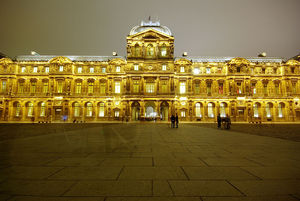The Louvre in Paris, France has a long, rich history. Throughout its existence, the Louvre has been transformed into one of the most beautiful and historic pieces of architecture in the world. Today it also has the status of being one of the world’s largest museums. Because of the beauty of this building and the art that it encapsulates, the Louvre has become dear to the hearts, not only of Parisians, but of art and history lovers everywhere.
The Louvre was originally a fortress that was built on the banks of the Seine River. The fortress was erected in the latter part of the 12th century; it was commissioned by King Phillipe Auguste. Eventually, the city around the fortress grew and the fortress became surrounded by residential buildings. From a military standpoint, the building had become useless and needed a new purpose.
During the reign of Charles V, the Louvre became a royal residence. In 1364 Charles V had artwork, ornate windows and staircases added to the structure. At this time the interior was redecorated and a garden was added to the grounds.
After the death of Charles V’s son, Charles VI in 1422 the Louvre remained unused for more than one hundred years. In 1527 Francois I called for the demolition of the original keep (La Grosse Tour). He then rebuilt the palace in Renaissance style. In 1665 the colonnade was designed by Gian Lorenzo Bernini and added to the Louvre at the request of Louis XIV. Over the years the kings of France added to the splendor of the Louvre. Napoleon III even added state apartments to the Richelieu Wing.
Throughout the years, the king’s had introduced art to the Louvre and eventually, in 1793, the palace became a museum of fine art. The building now has an area of more than 60,000 sq. ft. and houses more than 35,000 pieces of art. Visitors to the Louvre today can see some of the most historically significant art of all time, such as the Venus de Milo and Da Vinci’s Mona Lisa.
The most recent additions to the Louvre are a set of glass pyramids. The Louvre Pyramid and its two smaller counterparts were commissioned in 1984. The Louvre Pyramid now serves as an entrance to the museum. A fourth pyramid, La Pyramide Inversee, was built in 1993. It is smaller than the Louvre pyramid and is upside down underground. It is easy to miss the top of it from the outside, but it can be viewed in its entirety from the inside of the Louvre. There is also a small stone pyramid below La Pyramide Inversee that is lined up with it tip to tip. These pyramids are often thought of as an eyesore because they so starkly contrast the classical style of the building itself.
The Louvre is now more than 800 years old and is a historical treasure. Some of the artifacts in the Louvre predate the building by more than one thousand years, making them more than two thousand years old. Hopefully the Louvre and its treasures will remain for even longer than they have existed so that mankind will be able to admire them for many thousands of years.
Sources
History of the Louvre
Musee de Louvre
Louis XIII, retrieved 6/30/09, wikipedia.org/Louis_XII, retrieved 6/30/09, destination360.com/europe/france/musee-du-louvre, retrieved 6/30/09, louvre.fr/llv/musee/histoire_louvre.jsp?bmlocale=en



